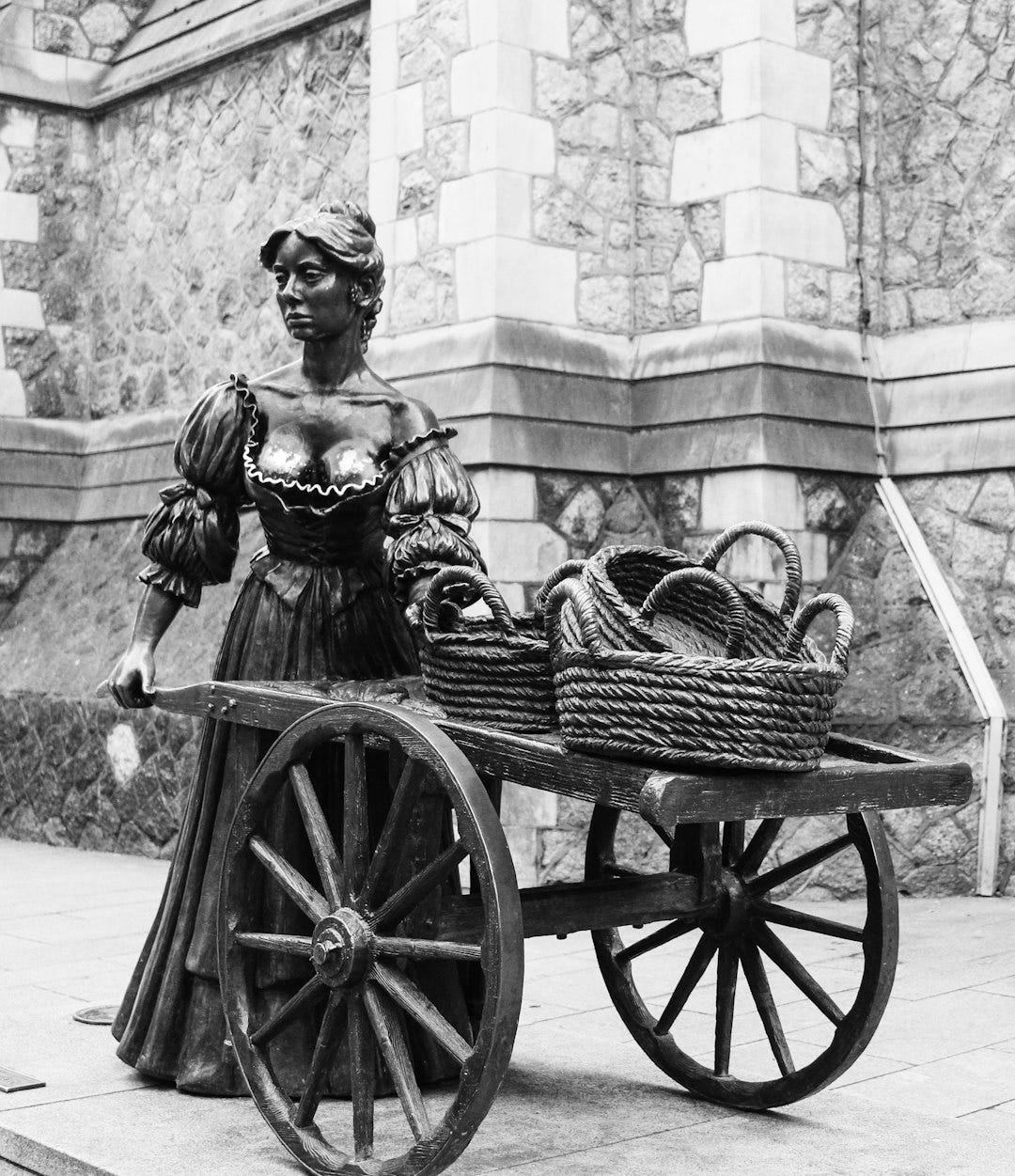Listen to Mary Swander’s Buggy Land St. Patrick’s Day Special Podcast. Irish music with Sean Fitzgerald and John Corless. Uilleann pipes, tin whistle, lilting, vocal solos. Interview with historian Roger Duffey on the history of the Irish-Amish settlements in Buggy Land. Host Mary Swander’s poem “Quay” and monologue “A Night of Craic and a Jug of Poitin.”
A Night of Craic and a Jug of Poitín
Often, I make my annual visit to Ireland soon after the first of the year. At that time in Iowa, the snow is usually drifting shut the pasture gate, the wind shooting down through my parka to anesthetize any little inch of bare skin.
“Why in the world are you coming to Ireland at this time of year?” my Irish friends ask. To them, the weather in their country is miserable with steady rain and winds spraying ocean water up against the sea wall.
In the mid-nineteenth century, the Famine Irish were urged to emigrate to the Midwest in hopes of claiming “free” land. When they got here, they were astonished by the cold and they would have turned around and gone back home if there had been a there there. The Scandinavian immigrants thought the Irish lazy, huddled around the hearth in the winter.
To me, winter in Ireland feels like spring. The temperature usually holds between 40-50 degrees. A few bricks of turf in the fire take the chill out of the room. You can relax with a cup of tea and forget you’d ever heard the words “blizzard.”
But I don’t come to Ireland for the weather. I come for the landscape, the literary tradition, the folklore, and most of all, for the friendship and the craic.
Craic (pronounced crack) means anything fun-- from an old-fashioned joke, to a dance or dinner party. Craic inevitably contains banter and repartee. An evening of socializing can be craic, and a person can also be craic. Someone is deemed “good craic,” if they have a sense of humor, can recite poetry, tell a story, perform music, dance or sing—all while interacting with a group of others.
In Ireland, craic is the connecting thread of the society. When you meet someone, they might ask, “What’s the craic?” The phrase can mean anything from “How are you?” to “What’s the gossip?” A person that is great craic is great fun or company. Minus craic means you would have more fun waiting in a doctor’s office reception room. Someone devoid of craic might as well lie down on a mountain road alone and surrender to the elements.
Years ago, some of my Irish friends moved to Switzerland. There, they were surrounded by the Alps, in an affluent, well-maintained, well-run country. In a year, they moved back to Ireland, taking a financial hit. “No craic in Switzerland,” they explained.
Craic was derived from an Old English word cracian, to make a loud noise or to brag or boast. Crack. Then it meant the sound of thunder or the crack of a whip. Both Robert Fergusson and Robert Burns used it in the 1770-80s. But the Irish eventually claimed it, spelling it their way, solidifying its meaning as “a sense of fun” and firmly incorporating it into their vocabulary.
So, there’s nothing I love more than arriving in Ireland to a dinner table of folks telling stories and filling the air with craic. At these events, my friends frequently tell tales of me coping with the Irish weather. Once, I had been offered the use of a lovely cottage on the Renvyle Peninsula, a stove set up in the middle room, the walls lined with books of classical poetry.
The place had rested at the bottom of a slope, down a lane, just a sight distance to the sea. All had been readied, and I yearned to trot down that lane, and set up my writing desk. But a couple of nights before my arrival, a herd of cattle had wandered onto the property and camped on the path, leaving a long, thick pile of their droppings. High alert! Several friends had come to the rescue with a wheelbarrow and shovels, attempting to clear the lane. But the rains kept washing more manure down near the cottage door.
“Oh, we can’t have Mary Swander arrive to a fecking pile of shite!”
My friends were shoveling and toting the wheelbarrow again and again, but the manure just kept descending.
“Don’t worry about it,” I had told my friends when I’d called from the Dublin bus headed to Galway. “A few cow pies aren’t going to bother me.” We passed the Ha’Penny Bridge and the statue of Molly Malone, and I thought all was smooth sailing.
Photo by Sophie Popplewell on Unsplash
“Nothing phases her,” my friend had said at the dinner party. “Mary just pulled on her Wellies and skated through that mess like it was nothing at all.”
And then the whole table fell into a hilarious round of good craic--stories about literal and figurative piles of muck. The stories began quietly enough, our knives and forks dug into our lamb shanks and potatoes. Wine glasses were filled and filled again. In my mind, Molly Malone wheeled her wheelbarrow down streets wide and narrow until she found my lane. She joined the clean-up crew, but even Molly couldn’t keep up with the cascading dung.
Dessert was served. Tea cups rattled. Then wrapped up in a brown paper bag, out came a bottle of poitín, (pronounced po-cheen), potent Irish bootlegged whiskey.
Poitín was a traditional “value added” product of the Irish countryside made from barley or potatoes. In the old days, small farmers could make enough money with poitín to pay rent to their British landowners. The Brits tried to tax the liquor but had a hard time tracking down the distilleries that were hidden in the sides of mountains, often on a lot line, so no one knew who really owned the hooch.
In 1661, King Charles finally banned the spirit, and simply drove the liquor further underground.
At the party, the bottle went round the table. Shot glasses appeared. One tiny whiff of the stuff sent my body reeling. Steady me. Take me back to Buggy Land. Cockles and mussels, was I still alive, alive-o? Now my friends were toasting the New Year. Oh, it was going to be a flip of the flipping calendar. She was a fishmonger. And sure ‘twas no wonder. Good craic. For so were her father and mother before. Mighty craic. Cockles and mussels, I slid down the lane of my brain alive, alive-o into a pile that was nothing you would ever, ever find in Switzerland:
She died in a fever,
And no one could save her.
And that was the end
Of sweet Mary Swander.
All paid subscriptions are tax-deductible and help fund AgArts, a non-profit designed to imagine and promote healthy food systems through the arts.
The Iowa Writers Collaborative
Have you explored the voices of Iowa Writers’ Collaborative? The writers contribute commentary, feature stories, and podcasts of interest. Please consider a paid subscription. It helps keep them going, and it keeps you in the know.









Share this post